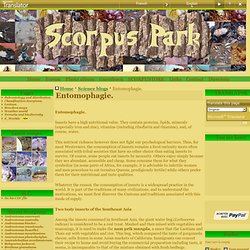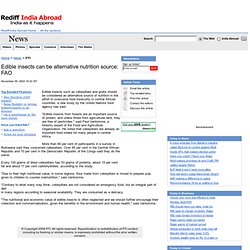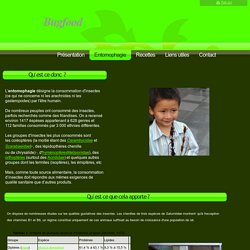

Les besoins alimentaires de l'Homme. Le forum dédié à l'entomophagie: manger des insectes comestibles, en trouver, en élever, se documenter, partager, échanger, en parler, etc. But: réunir tous les insectivores et entomophages au sein d'une même communauté Entomov. Entomophagie. - Site sur le bon maintien de scorpions en captivités = SCORPUS PARK. Entomophagie.

Insects have a high nutritional value. They contain proteins, lipids, minerals (especially iron and zinc), vitamins (including riboflavin and thiamine), and, of course, water. This nutrient richness however does not fight our psychological barriers. Thus, for most Westerners, the consumption of insects remains a food curiosity more often associated with tribal societies that have no other choice than eating insects to survive. Of course, some people eat insects by necessity.
Whatever the reason, the consumption of insects is a widespread practice in the world. Two tasty insects of the Southeast Asia Among the insects consumed in Southeast Asia, the giant water bug (Lethocerus indicus) is considered to be a real treat. A second popular insect in the East for its food is the silkworm chrysalis. Large quantities of pupae made available by the silk industry gave rise to many other dietary habits in the producing countries.
An Ant by day, a health guarantee! "It is rubbery. CHOI. IAF What is Entomophagy? Entomophagy is the practice of eating insects - including arachnids (tarantulas) and myriapods (centipedes).

The word “entomophagy” derives from the Greek term éntomos, or éntomon, meaning, “insect(ed),” literally meaning “cut in two,” referring to an insect’s segmented body, and phăgein, “to eat.” Combined, the two terms mean, “insect eating.” As a point of information the word itself is a rather new term. There’s no record of its coinage in the Oxford English Dictionary and its first usage to denote a human behavior may well be as recent as the 1950s. There are no words equivalent to ‘entomophagy’ in the languages of the many ethnic groups that practice insect consumption, simply because these peoples never distinguished between insects and other varieties of food. The History of Entomophagy. Insects can be alternative nutrition source: FAO. Home > News > PTI Edible insects can be alternative nutrition source: FAO November 09, 2004 15:32 IST Edible insects such as caterpillars and grubs should be considered an alternative source of nutrition in the effort to overcome food insecurity in central African countries, a new study by the United Nations food agency has said.

"Edible insects from forests are an important source of protein, and unlike those from agricultural land, they are free of pesticides," said Paul Vantomme, a forestry expert of the Food and Agriculture Organisation. He noted that caterpillars are already an important food intake for many people in central Africa. More than 90 per cent of participants in a survey in Botswana said they consumed caterpillars. Every 100 grams of dried caterpillars has 53 grams of proteins, about 15 per cent fat and about 17 per cent carbohydrates, according to the study.
Entomophagy and insects for feed. Bugfood > Entomophagie. Les études estimant la valeur nutritive des insectes donnent des résultats probants.

Dans la grande majorité des cas, les résultats placent les insectes en très bonne position sur la liste des aliments les plus nutritifs. Les insectes se classent avantageusement en ce qui a trait à leur contenu en protéines.Sous forme séchée, ils présentent alors une teneur élevée en protéines.Cette proportion est supérieur à 60/100 chez plusieurs espèces,et peux même atteindre 82/100. A titre de comparaison, toujours en poids sec, la teneur en protéines du poulet n'excède pas 23/100, celle du boeuf, 19/100 et celle du porc 17/100. Les insectes sont riche en Lysine et en Thréonine, substances qui font souvent défaut dans l'alimentaion à base de blé,de riz et de mais. La Chitine, qui constitue environ 10/100 du poids sec d'un insecte, est concidérée comme une source de fibre alimentaire et peut contribuer au bon fonctionnement des intestins.
Edible Insects – As An Alternative Source Of Food. Entomophagy, or the art and culture of eating arthropods (invertebrate) animals that have a jointed body and limb, particularly insects, is actually very common in many parts of the world.

To this day, however, entomophagy is not a day to day event because of the unavailability of a regular supply of edible insects and prevalence of other cheaper food alternatives in urban and rural communities Other negative factors are the concerns over the quality and food safety of edible insects collected from the wild and lack of public awareness of the nutritive value of edible insects. As far as species of insects eaten by people across the world is concern, there are approximately 1400 species known.
In African countries about 27 species are commonly consumed; in the Americas, 23 species; in Asia Pacific countries, 29 species of edible insects are eaten. The Philippines also has one of the richest arthropods fawns in the world. Comments.
Vidéos Pearltrees.